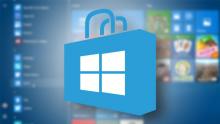
Ever clicked on that little shopping bag icon on your Windows 10 taskbar? Microsoft has come along way with some Windows helper apps that are in various stages of development. Many are released broadly for Windows 10 while others are currently being tested by those of us who participate in the Windows Insider Preview program.
That is right – the three rings in the Windows Insider Program are not just for testing updated development builds for the next feature update to Windows 10. Many of the app development teams now use these rings to test their apps and new features in a smaller test environment. If you do not want to test early development builds, then Release Preview, which doesn’t get builds until very late in the development process, is the perfect spot to help test out new features in some of these apps.
Let’s check out a few of these apps.
Windows 10 Photos App
The Photos app from Microsoft is also pinned to my Start Menu right alongside Polyview and Adobe Photoshop Essentials because it is the go-to app I use for general photo management and basic edits.
It connects to your Pictures directory on the local device plus your OneDrive photos that are stored in the cloud and provides a timeline view of your image collection. It can perform several functions that will suffice for most users:
• Cropping
• Resize using Small, Medium, and Large sizes
• Multiple filter overlays
• Redeye removal
• Inking/Drawing support
• 3D Effects
• Animated text
• Video creation with music and other effects
• Image tagging to facilitate easier search plus some AI is used to help identify objects in your images
• Image import from USB devices and option to add other folders containing images
• System-wide sharing to supported apps
Windows 10 Snip & Sketch App
Beginning with the Windows 10 October 2018 Update, whenever it gets properly released to the general public, Microsoft is phasing out the popular Snipping Tool that has been part of Windows 10 since its initial release back in July 2015.
This handy tool is being replaced by the Snip & Sketch app that includes features that allow you to use a new shortcut, pressing just the PRINT SCREEN button on your device, to open a small toolbar at the top of your screen to grab snips of activity on your device. There are options to grab rectangular, free-form, or full-screen snips.
Recent app updates have added options to capture delayed snips (3 or 10 seconds) and the team is planning to add the ability to capture open app windows.
Notifications for snips are listed in the Action Center and from there you can open them up in the Snip & Sketch app. From there you can annotate them using inking, highlighting, and other tools. Once complete you can save them to your local or OneDrive cloud storage.
One feature that is missing from the Snip & Sketch app is automatically saving any snips when they are captured. Currently, if you press WINDOWS KEY + PRINT SCREEN, those full screenshots are saved to your Screenshots folder. That is the default Windows behavior. I understand that the team knows this capability is very important if the Snipping Tool Is being phased out and that users want to ability to actually save any snip they take using the Snip & Sketch tools and not just those invoked with the WINDOWS KEY + PRINT SCREEN shortcut previously mentioned.
If you share a lot of snips to social media, the snip action of the new tools do store that snip in the clipboard so it is immediately available to paste into other apps including Twitter, Facebook, and other apps.
Windows 10 Cloud Clipboard
This is another app that is being introduced on the yet to be released Windows 10 October 2018 Update.
The premise is very straightforward – as you are working on your Windows 10 device and copy items like text and images, they are being stored in the Cloud Clipboard. Although images are not shared across devices, text snippets are so you can easily access those items on other supported devices.
Like many of you, I use a password manager and am constantly copying text-based passwords to be pasted into apps and forms. There are options in Cloud Clipboard to disable the automatic sharing of text-based items to prevent these from being shared across devices.
Clipboard items listed in the Cloud Clipboard and cleared on each restart of your system unless you pin them in the app UI to retain them.
While this is a handy app, it has a lot of overhead to make sure information is shared (or not shared) across devices and retained for evergreen clipboard items. The next app solves some of these issues very easily.
Cloud Clipboard is installed as part of Windows 10.
Windows 10 Sticky Notes App
The initial version of Sticky Notes for Windows 10 was a local-only app that did not sync your notes across devices. The 3.0 version of Sticky Notes adds that sync capability and uses the OneNote sync engine to keep those notes aligned across all your supported devices.
I am now using Sticky Notes to sync key text items across devices rather than the Cloud Clipboard. There is no automatic entry creation if I happen to copy a password into the clipboard, nor do I have to worry about losing that entry if I restart my device. By adding it into a note, that is shared across devices and is available almost immediately for use. I much prefer this process to the process of forgetting to pin or sync a non-password text clip in Cloud Clipboard and then losing that item.
Since I move between devices during the day, I find using Sticky Notes Version 3.0 the best way to move text data between systems as I am working. Sticky Notes, just like Cloud Clipboard, does not support sharing images through the app across devices, but that is solved easily enough using OneDrive and the Screenshots folder.
You can help make this column better by sharing your topic suggestions, tips or experiences you have had with your own tech with the Sangat through this column in our Ashram newsletter. Email me and tell me your story, and keep sending me your suggestions for column topics, along with your own favorite smartphone app recommendations and reviews so I can share them here. Just email them to me at [email protected]








